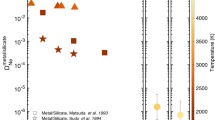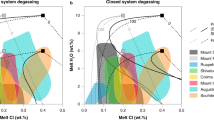Abstract
Degassing of the Earth is still poorly understood, as is the large scatter in He/Ar ratios observed in mid-ocean ridge basalts. A possible explanation for such observations is that vesiculation occurs at great depths with noble-gas solubilities different from those measured at 1 bar (ref. 1). Here we develop a hard-sphere model for noble-gas solubility and find that, owing to melt compaction, solubility may decrease by several orders of magnitude when pressure increases, an effect subtly overbalanced by the compression of the fluid phase. Our results satisfactorily explain recent experimental data on argon solubility in silicate melts, where argon concentration increases almost linearly with pressure, then levels off at pressures of 50–100 kbar (refs 2–5). We also model vesiculation during magma ascent at ridges and find that noble-gas partitioning between melt and CO2 vesicles at depth differs significantly from that at low pressure. Starting at 10 kbar (∼35 km depth), several stages of vesiculation occur followed by vesicle loss, which explains the broad variability of He–Ar concentration data in mid-ocean ridge basalts. ‘Popping rocks’, exceptional samples with high vesicularity, may represent fully vesiculated ridge magma, whereas common samples would simply have lost such vesicles.
This is a preview of subscription content, access via your institution
Access options
Subscribe to this journal
Receive 51 print issues and online access
$199.00 per year
only $3.90 per issue
Buy this article
- Purchase on Springer Link
- Instant access to full article PDF
Prices may be subject to local taxes which are calculated during checkout




Similar content being viewed by others
References
Sarda, P. & Moreira, M. Vesiculation and vesicle loss in mid-ocean ridge basalt glasses: He, Ne, Ar elemental fractionation and pressure influence. Geochim. Cosmochim. Acta 66, 1449–1458 (2002)
White, B. S., Brearley, M. & Montana, A. Solubility of argon in silicate liquid at high pressures. Am. Mineral. 74, 513–529 (1989)
Carroll, M. R. & Stolper, E. M. Noble gas solubilities in silicate melt and glasses: new experimental results for argon and the relationship between solubility and ionic porosity. Geochim. Cosmochim. Acta 57, 5039–5051 (1993)
Chamorro-Perez, E., Gillet, Ph. & Jambon, A. Argon solubility in silicate melts at very high pressures. Experimental set-up and preliminary results for silica and anorthite melts. Earth Planet. Sci. Lett. 145, 97–107 (1996)
Schmidt, B. C. & Keppler, H. Experimental evidence for high noble gas solubilities in silicate melts under mantle pressures. Earth Planet. Sci. Lett. 195, 277–290 (2002)
Andersen, H. C., Weeks, J. D. & Chandler, D. Relationship between the hard-sphere fluid and fluids with realistic repulsive forces. Phys. Rev. A. 4, 1597–1605 (1971)
Carnahan, N. F. & Starling, K. E. Equation of state for nonattracting rigid spheres. J. Chem. Phys. 51, 635–636 (1969)
Song, Y. & Mason, E. A. Statistical-mechanical theory of a new analytical equation of state. J. Chem. Phys. 91, 7840–7853 (1989)
Bottinga, Y., Richet, P. & Weill, D. F. Calculation of the density and thermal expansion coefficient of silicate liquids. Bull. Minéral. 106, 129–138 (1983)
Reiss, H., Frisch, H. L., Helfand, E. & Lebowitz, J. L. Aspects of the statistical thermodynamics of real fluids. J. Chem. Phys. 32, 119–124 (1960)
Guillot, B. & Guissani, Y. The solubility of rare gases in fused silica: a numerical evaluation. J. Chem. Phys. 105, 255–270 (1996)
Jambon, A., Weber, H. & Braun, O. Solubility of He, Ne, Ar, Kr, Xe in a basalt melt in the range 1250–1600 °C. Geochemical implications. Geochim. Cosmochim. Acta 50, 401–408 (1986)
Chamorro-Pérez, E., Gillet, Ph., Jambon, A., Badro, J. & McMillan, P. Low argon solubility in silicate melts at high pressure. Nature 393, 352–355 (1998)
Bottinga, Y. & Javoy, M. MORB degassing: bubble growth and ascent. Chem. Geol. 81, 255–270 (1990)
Sarda, P. & Graham, D. Mid-ocean ridge popping rocks: implications for degassing at ridge crests. Earth Planet. Sci. Lett. 97, 268–289 (1990)
Javoy, M. & Pineau, F. The volatiles record of a “popping” rock from the mid-atlantic ridge at 14 °N: chemical and isotopic composition of gas trapped in the vesicles. Earth Planet. Sci. Lett. 107, 598–611 (1991)
Burnard, P., Graham, D. & Turner, G. Vesicle-specific noble gas analyses of ‘popping rock’: implications for primordial noble gases in the Earth. Science 276, 568–571 (1997)
Graham, D. & Sarda, P. Reply to comment by T.M. Gerlach on ‘Mid-ocean ridge popping rocks: implications for degassing at ridge crests’. Earth Planet. Sci. Lett. 105, 568–573 (1991)
Moreira, M., Kunz, J. & Allègre, C. Rare gas systematics in popping rock: isotopic and elemental compositions in the upper mantle. Science 279, 1178–1181 (1998)
Allègre, C. J., Staudacher, T. & Sarda, P. Rare gas systematics: formation of the atmosphere, evolution and structure of the Earth's mantle. Earth Planet. Sci. Lett. 81, 127–150 (1987)
Ballentine, C. J., van Keken, P. E., Porcelli, D. & Hauri, E. H. Numerical models, geochemistry and the zero-paradox noble gas mantle. Phil. Trans. R. Soc. Lond. A 360, 2611–2631 (2002)
Rigden, S. M., Ahrens, T. J. & Stolper, E. M. Densities of liquid silicates at high pressures. Science 226, 1071–1074 (1984)
Gaetani, G. A., Asimow, P. D. & Stolper, E. Determination of the partial molar volume of SiO2 in silicate liquids at elevated pressures and temperatures: a new experimental approach. Geochim. Cosmochim. Acta 62, 2499–2508 (1998)
Agee, C. B. & Walker, D. Static compression and olivine flotation of ultrabasic silicate liquid. J. Geophys. Res. 93, 3437–3449 (1988)
Kirsten, T. Incorporation of rare gases in solidifying enstatite melts. J. Geophys. Res. 73, 2807–2810 (1968)
Shibata, T., Takahashi, E. & Matsuda, J.-I. Solubility of neon, argon, krypton and xenon in binary and ternary silicate systems: a new view on noble gas solubility. Geochim. Cosmochim. Acta 62, 1241–1253 (1998)
Carroll, M. R. & Draper, D. S. Noble gases as trace elements in magmatic processes. Chem. Geol. 117, 37–56 (1994)
Mourtada-Bonnefoi, C. C. & Laporte, D. Kinetics of bubble nucleation in a rhyolitic melt: an experimental study of the effect of ascent rate. Earth Planet. Sci. Lett. 218, 521–537 (2004)
Pan, V., Holloway, J. R. & Hervig, R. L. The pressure and temperature dependence of carbon dioxide solubility in tholeiitic basalt melts. Geochim. Cosmochim. Acta 55, 1587–1595 (1991)
Acknowledgements
We thank P. Burnard for sharing data and discussions, and P. Richet for discussions and encouragements.
Author information
Authors and Affiliations
Corresponding author
Ethics declarations
Competing interests
Reprints and permissions information is available at npg.nature.com/reprintsandpermissions. The authors declare no competing financial interests.
Supplementary information
Supplementary Notes
A development of the model in some detail, references to the literature, and a legend for the Supplementary Figure S1. (DOC 264 kb)
Supplementary Figure S1
Two diagrams showing pressure (in kbar) vs. density (in g/cm3) for gases and for various silicate liquids, both using the Carnahan Starling equation of state. (PDF 66 kb)
Rights and permissions
About this article
Cite this article
Sarda, P., Guillot, B. Breaking of Henry's law for noble gas and CO2 solubility in silicate melt under pressure. Nature 436, 95–98 (2005). https://doi.org/10.1038/nature03636
Received:
Accepted:
Issue Date:
DOI: https://doi.org/10.1038/nature03636
This article is cited by
-
Formation and Evolution of Protoatmospheres
Space Science Reviews (2016)
-
Seawater subduction controls the heavy noble gas composition of the mantle
Nature (2006)
Comments
By submitting a comment you agree to abide by our Terms and Community Guidelines. If you find something abusive or that does not comply with our terms or guidelines please flag it as inappropriate.



